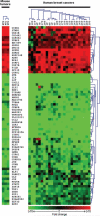From mice to humans: identification of commonly deregulated genes in mammary cancer via comparative SAGE studies
- PMID: 15520179
- PMCID: PMC4170686
- DOI: 10.1158/0008-5472.CAN-04-1827
From mice to humans: identification of commonly deregulated genes in mammary cancer via comparative SAGE studies
Abstract
Genetically engineered mouse mammary cancer models have been used over the years as systems to study human breast cancer. However, much controversy exists on the utility of such models as valid equivalents to the human cancer condition. To perform an interspecies gene expression comparative study in breast cancer we used a mouse model that most closely resembles human breast carcinogenesis. This system relies on the transplant of p53 null mouse mammary epithelial cells into the cleared mammary fat pads of syngeneic hosts. Serial analysis of gene expression (SAGE) was used to obtain gene expression profiles of normal and tumor samples from this mouse mammary cancer model (>300,000 mouse mammary-specific tags). The resulting mouse data were compared with 25 of our human breast cancer SAGE libraries (>2.5 million human breast-specific tags). We observed significant similarities in the deregulation of specific genes and gene families when comparing mouse with human breast cancer SAGE data. A total of 72 transcripts were identified as commonly deregulated in both species. We observed a systematic and significant down-regulation in all of the tumors from both species of various cytokines, including CXCL1 (GRO1), LIF, interleukin 6, and CCL2. All of the mouse and most human mammary tumors also displayed decreased expression of genes known to inhibit cell proliferation, including NFKBIA (IKBalpha), GADD45B, and CDKN1A (p21); transcription-related genes such as CEBP, JUN, JUNB, and ELF1; and apoptosis-related transcripts such as IER3 and GADD34/PPP1R15A. Examples of overexpressed transcripts in tumors from both species include proliferation-related genes such as CCND1, CKS1B, and STMN1 (oncoprotein 18); and genes related to other functions such as SEPW1, SDFR1, DNCI2, and SP110. Importantly, abnormal expression of several of these genes has not been associated previously with breast cancer. The consistency of these observations was validated in independent mouse and human mammary cancer sets. This is the first interspecies comparison of mammary cancer gene expression profiles. The comparative analysis of mouse and human SAGE mammary cancer data validates this p53 null mouse tumor model as a useful system closely resembling human breast cancer development and progression. More importantly, these studies are allowing us to identify relevant biomarkers of potential use in human studies while leading to a better understanding of specific mechanisms of human breast carcinogenesis.
Figures



Similar articles
-
Transcriptomic changes in human breast cancer progression as determined by serial analysis of gene expression.Breast Cancer Res. 2004;6(5):R499-513. doi: 10.1186/bcr899. Epub 2004 Jul 6. Breast Cancer Res. 2004. PMID: 15318932 Free PMC article.
-
Genes affected by mouse mammary tumor virus (MMTV) proviral insertions in mouse mammary tumors are deregulated or mutated in primary human mammary tumors.Oncotarget. 2012 Nov;3(11):1320-34. doi: 10.18632/oncotarget.682. Oncotarget. 2012. PMID: 23131872 Free PMC article.
-
Integrated miRNA and mRNA expression profiling of mouse mammary tumor models identifies miRNA signatures associated with mammary tumor lineage.Genome Biol. 2011 Aug 16;12(8):R77. doi: 10.1186/gb-2011-12-8-r77. Genome Biol. 2011. PMID: 21846369 Free PMC article.
-
A mouse mammary gland involution mRNA signature identifies biological pathways potentially associated with breast cancer metastasis.J Mammary Gland Biol Neoplasia. 2009 Jun;14(2):99-116. doi: 10.1007/s10911-009-9120-1. Epub 2009 Apr 30. J Mammary Gland Biol Neoplasia. 2009. PMID: 19408105 Review.
-
The genetic components of susceptibility to breast cancer in the rat.Prog Exp Tumor Res. 1999;35:158-69. doi: 10.1159/000062012. Prog Exp Tumor Res. 1999. PMID: 10377759 Review.
Cited by
-
Testing breast cancer serum biomarkers for early detection and prognosis in pre-diagnosis samples.Br J Cancer. 2017 Feb 14;116(4):501-508. doi: 10.1038/bjc.2016.433. Epub 2017 Jan 12. Br J Cancer. 2017. PMID: 28081538 Free PMC article. Clinical Trial.
-
Identification of modulated genes by three classes of chemopreventive agents at preneoplastic stages in a p53-null mouse mammary tumor model.Cancer Prev Res (Phila). 2009 Feb;2(2):175-84. doi: 10.1158/1940-6207.CAPR-08-0104. Epub 2009 Jan 27. Cancer Prev Res (Phila). 2009. PMID: 19174580 Free PMC article.
-
Photo-Functionalized Magnetic Nanoparticles as a Nanocarrier of Photodynamic Anticancer Agent for Biomedical Theragnostics.Cancers (Basel). 2020 Mar 1;12(3):571. doi: 10.3390/cancers12030571. Cancers (Basel). 2020. PMID: 32121558 Free PMC article.
-
Abnormal expression of GADD45B in human colorectal carcinoma.J Transl Med. 2012 Oct 30;10:215. doi: 10.1186/1479-5876-10-215. J Transl Med. 2012. PMID: 23110778 Free PMC article.
-
Transcriptional responses to estrogen and progesterone in mammary gland identify networks regulating p53 activity.Endocrinology. 2008 Oct;149(10):4809-20. doi: 10.1210/en.2008-0035. Epub 2008 Jun 12. Endocrinology. 2008. PMID: 18556351 Free PMC article.
References
-
- Moody SE, Sarkisian CJ, Hahn KT, et al. Conditional activation of Neu in the mammary epithelium of transgenic mice results in reversible pulmonary metastasis. Cancer Cell. 2002;2:451–61. - PubMed
-
- Cardiff RD, Anver MR, Gusterson BA, et al. The mammary pathology of genetically engineered mice: the consensus report and recommendations from the Annapolis meeting. Oncogene. 2000;19:968–88. - PubMed
-
- Jerry DJ, Kittrell FS, Kuperwasser C, et al. A mammary-specific model demonstrates the role of the p53 tumor suppressor gene in tumor development. Oncogene. 2000;19:1052–8. - PubMed
-
- Medina D, Kittrell FS, Shepard A, Contreras A, Rosen JM, Lydon J. Hormone dependence in premalignant mammary progression. Cancer Res. 2003;63:1067–72. - PubMed
Publication types
MeSH terms
Substances
Grants and funding
LinkOut - more resources
Full Text Sources
Other Literature Sources
Medical
Research Materials
Miscellaneous

